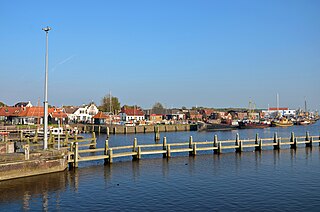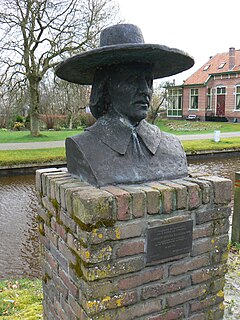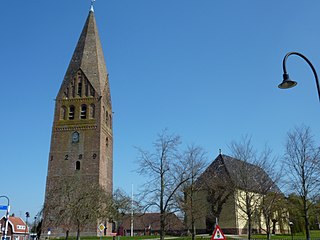
Zoutkamp is a village in the municipality Het Hogeland which is part of the province Groningen in the Netherlands. The village started as a sconce. During the Dutch Revolt, it was the site of the Battle of Zoutkamp. Later it became a fishing village. The harbour was moved to Lauwersoog in 1969 as a result of the closure of the Lauwersmeer, and is nowadays used for recreational purposes. The economy of the village mainly depends on fishing.

Sportclub Veendam was a Dutch professional association football club based in Veendam, province of Groningen. Founded on 4 September 1894 as Look-Out, it became P.J. Veendam in 1909, Veendam in 1910, SC Veendam in 1974, BV Veendam in 1997 and again SC Veendam in 2011. The club was a founder member of the regional first tier Eerste Klasse Noord in 1916 and became champions of the division in 1931–32; it qualified for the national championship play-offs but finished in bottom place. Veendam took part in the inaugural season of the third tier Tweede Divisie in 1956–57; after yo-yoing between the third and second tiers, the team won promotion to the first tier Eredivisie for the first time in 1985–86. The side spent two seasons in the Eredivisie—1986–87 and 1988–89—but were relegated both times. Veendam then competed in the second tier Eerste Divisie until they were dissolved due to financial problems in 2013.

Beerta is a village and former municipality with a population of 2,205 in the municipality of Oldambt in the province of Groningen in the Netherlands. In the 20th century, Beerta was a communist stronghold. In 1933, the municipal council was dismissed by the government, and was ruled by a government commissioner until 1935. Between 1982 and 1990, Beerta was the only municipality with a communist mayor.

Kloosterburen is a village in the Dutch province of Groningen. It is located in the municipality of het Hogeland. The village developed around a monastry. Kloosterburen was a separate municipality until 1990, when it was merged with Leens, Ulrum and Eenrum. During the combining of the four municipalities they were called 'de LEUK gemeenten'. In 2019, it became part of Het Hogeland.

Wedde is a village in the municipality Westerwolde in the province Groningen in the Netherlands. It is located 9 km southeast of Winschoten. The castle Wedderborg is located in the village.

Eurosonic Noorderslag is an annual four-day music showcase festival and conference held in January in Groningen, Netherlands. The first three days of the festival (Eurosonic) feature artists from all over Europe, the last day of the festival (Noorderslag) features only Dutch artists. The conference is held during all four days of the event. Several awards are presented during Eurosonic Noorderslag: the Music Moves Europe Talent Awards, the European Festivals Awards, the Buma Cultuur Pop Award (Popprijs), the Pop Media Award, The Feather, the "Iron Venue and Festival Animals" and the Buma Music Meets Tech Award.
Het Oude Jachthuis is a restaurant in Eursinge, near Pesse, in the Netherlands. It was a fine dining restaurant that was awarded one Michelin star in 1966 and retained that rating until 1980.

The Nieuwsblad van het Noorden is a former regional daily newspaper from the city of Groningen in the Netherlands. It was published from 1888 to 2002, when it was merged with the Groninger Dagblad and the Drentse Courant into the Dagblad van het Noorden, which published its first edition on 2 April 2002.

Lauwersoog is a seaside village and harbour in the province of Groningen, located in the northern part of the Netherlands. It is part of the municipality of Het Hogeland. It was established on 23 May 1969. The ferry to Schiermonnikoog departs from Lauwersoog.
The WNC squat was a self-managed social centre in Groningen, the Netherlands. It was squatted in 1985 and evicted in 1990.

VV Noordscheschut is a Dutch association football club from Noordscheschut, Netherlands. Its home ground is Sportpark De Meulewieke. Club colors are blue-white. Its first squad plays since 2020 in the Hoofdklasse Saturday.

Adriaan Geerts Wildervanck was a Dutch businessman and coloniser. In 1643, he lost most of his money when De Oevelgunne stranded on the Boschplaat with expensive lace. In 1647, he founded the Muntendammer Company to exploit a peat colony. As part of the colony, the villages of Wildervank (1647) and Veendam (1648) were established.

Kleine Huisjes is a village in the Dutch province of Groningen. It is a part of the municipality of Het Hogeland. It is located 1.5 kilometres (0.93 mi) north-east of Kloosterburen.

Boterdiep is a canal in the Province of Groningen in the Netherlands. It was intended for the inland navigation. The name relates to the dairy products transported through the canal. It used have its source in the centre of Groningen, but has been rerouted to the Van Starkenborghkanaal.

Foxhol is a village in the Dutch province of Groningen. It is part of the municipality of Midden-Groningen. In 1842, the potato starch factory Eureka was founded in Foxhol by Willem Albert Scholten. Foxhol became an industrial area with factories and shipyards. The village is nowadays part of the urban area of Hoogezand.

Schildwolde is a village in the Dutch province of Groningen. It is part of the municipality of Midden-Groningen. It is known for its detached church tower from the 13th century.

Visvliet is a village in the Dutch province of Groningen. It is part of the municipality of Westerkwartier, and is located near the river Lauwers, the border between Friesland and Groningen.

Westernieland is a village in the Dutch province of Groningen. It is part of the municipality of Het Hogeland. The village is located near the Wadden Sea.

Wehe-Den Hoorn is a village in the Dutch province of Groningen. It is part of the municipality of Het Hogeland. It is a 1966 merger of the villages of Wehe and Den Hoorn.





















